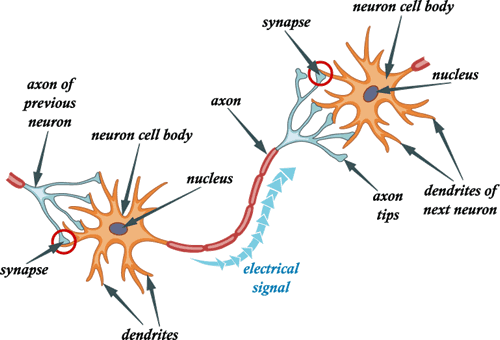For a long time, it was believed that as we aged, the connections in the brain became fixed. Research has shown that in fact the brain never stops changing through learning. Brain plasticity refers to the brain’s ability to change throughout life. The brain has the amazing ability to reorganize itself by forming new connections between brain cells (neurons).
With a new kind of microscope, Tobias Bonhoeffer 1999 observed and took videos of living neurons as they grew. Using tissue from rats, he placed live cells from a part of the brain that plays an important part in long-term memory into a nutrient solution, marked individual neurons with a fluorescent stain, and connected them with ultrathin electric wires. By repeatedly subjecting two neurons simultaneously to electric impulses, he stimulated two perceptions, corresponding, say, to signals like “stove” and “hot”. After half an hour, bumps grew out of the dendrites of the nerve cells – so-called dendritic spines, by which the neurons establish contact. A new connection between the synapses in the brain had been forged*. “Cells that fire together wire together,” as neurologists say.
When a blind person compensates for her lack of sight by developing her sense of touch, the borders of areas of the brain shift. This is most evident in the parts of the cerebral cortex that are responsible for the index finger. And it takes only a few seconds for this region to grow at the expense of others.
Not all systems in the brain are as flexible as the cerebral cortex. Some don’t change within days but takes weeks or even years to be restructured. London taxi drivers given brain scans by scientists at University College London had a larger hippocampus compared with other people. This is a part of the brain associated with navigation in birds and animals. The scientists also found part of the hippocampus grew larger as the taxi drivers spent more time in the job.
Rebuilding an entire area of the brain is possible but involves several steps to accomplish. A surprising consequence of neuroplasticity is that the brain activity associated with a given function can move to a different location as a consequence of normal experience, brain damage or recovery.
In his book “The Brain That Changes Itself: Stories of Personal Triumph from the Frontiers of Brain Science, Norman Doidge described a surgeon in his 50s who suffered a stroke. His left arm was paralyzed. During his rehabilitation, his good arm and hand were immobilized, and he was set to cleaning tables. The task was at first impossible. Then slowly the bad arm remembered how to move. He learned to write again, to play tennis again: the functions of the brain areas killed in the stroke had transferred themselves to healthy regions**!
Plasticity is the property of the brain that allows it to alter its biological, chemical and physical properties. As the brain changes, function and behavior are modified in a parallel course. New learning is at the heart of plasticity. The multiplicity of circumstances for the occasion of new learning raises the question of whether the brain will change whenever it is learning something. Research suggests that this is not the case. It appears that the brain will acquire new knowledge, and thereby actualize its potential for plasticity, if the new learning is behaviorally appropriate. New learning which ensures survival will be integrated by the organism and adopted as behavior and, as a result, the brain will be changed. Perhaps more important is the extent to which a learning experience is rewarding***.
According to current research, there are only a few functions that are, with training, impervious to development in adulthood. One of them is sight. Although it is true that we learn foreign languages most easily in childhood, you can still learn Arabic or Chinese at an advanced age.
And so is true with learning positive feelings. Connections in our brain determine how we feel, and they are more easily formed in childhood. But the prefrontal cortex can learn to direct them consciously and to prevent negative feelings from gaining the upper hand*.
When engaged in new learning and experience, the brain establishes neural pathways much like how a path is created in the woods through a persistent jogger’s following the same route daily. It takes hard work and conscious effort, but at the same time is enormously rewarding and life changing.
____________________________________________________________
* The Science of Happiness by Stefan Klein
** Brain Plasticity: How learning changes your brain by Dr. Pascale Michelon
***http://www.cognifit.com/brain-plasticity-and-cognition


I’m wondering how I might be notified when a new post has been made. I have subscribed to your RSS feed which must do the trick! Have a nice day.
June 17, 2013 @ 9:27 pm
With havin so much written content do you ever run into any problems of plagorism or copyright violation? My blog has a lot of unique content I’ve either authored myself or outsourced but it appears a lot of it is popping it up all over the internet without my permission. Do you know any techniques to help stop content from being stolen? I’d truly appreciate it.
May 2, 2013 @ 5:30 am
As old saying, learning something new every day.
But for those who refuses to learn, nothing ever matters. In your attitude, you’re a new person.
April 13, 2013 @ 9:38 pm